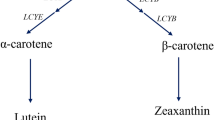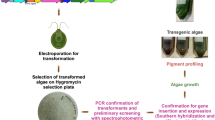Abstract
Dunaliella is a commercially important marine alga producing high amount of β-carotene. The use of Dunaliella as a potential transgenic system for the production of recombinant proteins has been recently recognized. The present study reports for the first time the metabolic engineering of carotenoid biosynthesis in Dunaliella salina for ketocarotenoid production. The pathway modification included the introduction of a bkt gene from H. pluvialis encoding β-carotene ketolase (4,4′β-oxygenase) along with chloroplast targeting for the production of ketocarotenoids. The bkt under the control of Dunaliella Rubisco smaller subunit promoter along with its transit peptide sequence was introduced into the alga through standardized Agrobacterium-mediated transformation procedure. The selected transformants were confirmed using GFP and GUS expression, PCR and southern blot analysis. A notable upregulation of the endogenous hydroxylase level of transformants was observed where the BKT expression was higher in nutrient-limiting conditions. Carotenoid analysis of the transformants through HPLC and MS analysis showed the presence of astaxanthin and canthaxanthin with maximum content of 3.5 and 1.9 µg/g DW, respectively. The present study reports the feasibility of using D. salina for the production of ketocarotenoids including astaxanthin.








Similar content being viewed by others
References
Anila N, Chandrashekar A, Ravishankar GA, Sarada R (2011) Establishment of Agrobacterium mediated genetic transformation in D. bardawil. Eur J Phycol 46(1):36–44
Arun N, Singh DP (2013) Differential response of Dunaliella salina and Dunaliella tertiolecta isolated from brines of Sambhar Salt Lake of Rajasthan (India) to salinities: a study on growth, pigment and glycerol synthesis. J Mar Biol Assoc India 55(1):65–70
Becker W (2004) Microalgae for aquaculture. The nutritional value of microalgae for aquaculture. In: Richmond A (ed) Handbook of microalgal culture. Blackwell, Oxford, pp 380–391
Ben Amotz A, Avron M (1983) On the factors which determine massive beta carotene accumulation in the halotolerant alga Dunaliella bardawil. Plant Physiol 72:593–597
Coesel SN, Baumgartner AC, Teles LM, Ramos AA, Henriques NM, Cancela L, Varela JCS (2008) Nutrient limitation is the main regulatory factor for carotenoid accumulation and for Psy and Pds steady state transcript levels in Dunaliella salina (Chlorophyta) exposed to high light and salt stress. Mar Biotechnol 10(5):602–611
Cottage A, Yang A, Maunders H, de Lacy RC, Ramsay NA (2001) Identification of DNA sequences flanking T-DNA insertions by PCR-walking. Plant Mol Biol 19(4):321–327
Degui G, Yiqin W, Wenbin L, Yongru S (2002) Transient expression of gus gene in Dunaliella salina. High Technol Lett 2:35–39
Dipak SP, Lele SS (2005) Carotenoid production from microalga Dunaliella salina. Indian J Biotechnol 4:476–483
Fraser PD, Römer S, Shipton CA, Mills PB, Kiano JW, Misawa N, Drake RG, Schuch W, Bramley PM (2002) Evaluation of transgenic tomato plants expressing an additional phytoene synthase in a fruit-specific manner. Proc Natl Acad Sci USA 99:1092–1097
Geng D, Wang Y, Wang P, Li W, Sun Y (2003) Stable expression of hepatitis B surface antigen gene in Dunaliella salina (Chlorophyta). J Appl Phycol 15:451–456
Goswami G, Chaudhuri S, Dutta D (2010) The present perspective of astaxanthin with reference to biosynthesis and pharmacological importance. World J Microbiol Biotechnol 26:1925–1939
Hata N, Ogbonna JC, Hasegawa Y, Taroda H, Tanaka H (2001) Production of astaxanthin by Haematococcus pluvialis in a sequential heterotrophic-photoautotrophic culture. J App Phycol 13:395–402
Hirschberg J (2001) Carotenoid biosynthesis in flowering plants. Curr Opin Plant Biol 4:210–218
Höfgen R, Willmitzer L (1988) Storage of competent cells for Agrobacterium transformation. Nucleic Acids Res 16(20):9877
Huang JC, Zhong YJ, Liu J, Sandmann G, Chen F (2013) Metabolic engineering of tomato for high-yield production of astaxanthin. Metab Eng 17:59–67
Jayaraj J, Devlin R, Punja Z (2008) Metabolic engineering of novel keto-carotenoid production in carrot plants. Transgen Res 17:489–501
Jin ES, Polle JE, Melis A (2001) Involvement of zeaxanthin and of the Cbr protein in the repair of photosystem II from photoinhibition in the green alga Dunaliella salina. Biochim et Biophys Acta 1506:244–259
Kajiwara S, Kakizono T, Saito T, Kondo K, Ohtani T, Nishio N, Nagai S, Misawa N (1995) Isolation and functional identification of a novel cDNA for astaxanthin biosynthesis from Haematococcus pluvialis, and astaxanthin synthesis in Escherichia coli. Plant Mol Biol 29:343–352
Kathiresan S, Chandrashekar A, Ravishankar GA, Sarada R (2015) Regulation of astaxanthin and its intermediates through cloning and genetic transformation β-carotene ketolase in Haematococcus pluvialis. J Biotechnol 196–197:33–41
Lamers PP, Janssen M, De Vos RCH, Bino RJ, Wijffels RH (2008) Exploring and exploiting carotenoid accumulation in Dunaliella salina for cell-factory applications. Trends Biotechnol 26:631–638
Lamers PP, van de Laak CCW, Kaasenbrood PS, Lorier J, Janssen M, De Vos RCH, Bino RJ, Wijffels RH (2010) Carotenoid and fatty acid metabolism in light-stressed Dunaliella salina. Biotechnol Bioeng 106:638–648
Lamers PP, Janssen M, De Vos RCH, Bino RJ, Wijffels RH (2012) Carotenoid and fatty acid metabolism in nitrogen-starved Dunaliella salina, a unicellular green microalga. J Biotechnol 162:21–27
León R, Couso I, Fernández E (2007) Metabolic engineering of ketocarotenoids biosynthesis in the unicelullar microalga Chlamydomonas reinhardtii. J Biotechnol 130:143–152
León-Bañares R, González-Ballester D, Galván A, Fernández E (2004) Transgenic microalgae as green cell-factories. Trend Biotechnol 22:45–52
Mann V, Harker M, Pecker I, Hirschberg J (2000) Metabolic engineering of astaxanthin production in tobacco flowers. Nat Biotechnol 18:888–892
Misawa N, Yamano S, Linden H, Felipe MR, Lucas M, Ikenaga H, Sandmann G (1993) Functional expression of the Erwinia uredovora carotenoid biosynthesis gene crtl in transgenic plants showing an increase of β-carotene biosynthesis activity and resistance to the bleaching herbicide norflurazon. Plant J 4(5):833–840
Misawa N, Kajiwara S, Konda K, Yokoyama A, Satomi Y, Saito T, Miki W, Ohtani T (1995a) Canthaxanthin biosynthesis by the conversion of methylene to keto groups in a hydrocarbon beta-carotene by a single gene. Biochem Biophys Res Commun 209:867–876
Misawa N, Satomi Y, Kondo K, Yokoyama A, Kajiwara S, Saito T, Ohtani T, Miki W (1995b) Structure and functional analysis of a marine bacterial carotenoid biosynthesis gene cluster and astaxanthin biosynthetic pathway proposed at the gene level. J Bacteriol 177:6575–6584
Morris WL, Ducreux LJ, Fraser PD, Millam S, Taylor MA (2006) Engineering ketocarotenoid biosynthesis in potato tubers. Metab Eng 8(3):253–263
Mulders KJ, Lamers PP, Martens DE, Wijffels RH (2014) Phototrophic pigment production with microalgae: biological constraints and opportunities. J App Phycol 50(2):229–242
Orset S, Young AJ (1999) Low-temperature induced synthesis of α-carotene in the microalga Dunaliella salina (Chlorophyta). J Phycol 35:527–549
Ralley L, Enfissi EMA, Misawa N, Schuch W, Bramley PM, Fraser PD (2004) Metabolic engineering of keto-carotenoid formation in higher plants. Plant J 39:477–486
Rosati Carlo, Aquilani Riccardo, Dharmapuri Sridhar, Pallara Patrizia, Marusic Carla, Tavazza Raffaela, Bouvier Florence, Camara Bilal, Giuliano Giovanni (2000) Metabolic engineering of beta-carotene and lycopene content in tomato fruit. Plant J 24(3):413–420
Shewmaker CK, Sheehy JA, Daley M, Colburn S, Ke DY (1999) Seed-specific overexpression of phytoene synthase: increase in carotenoids and other metabolic effects. Plant J 20:401–412
Stalberg K, Lindgren O, Ek B, Hoglund AS (2003) Synthesis of keto-carotenoids in the seed of Arabidopsis thaliana. Plant J 36:771–779
Sui X, Kiser PD, von Lintig J, Palczewski K (2013) Structural basis of carotenoid cleavage: from bacteria to mammals. Arch Biochem Biophys 539(2):203–213
Sun Y, Yang ZY, Gao XS, Li QY, Zhang QQ, Xu ZK (2005) Expression of foreign genes in Dunaliella by electroporation. Mol Biotechnol 30:185–192
Suzuki S, Nishihara M, Nakatsuka T, Misawa N, Ogiwara I, Yamamura S (2007) Flower color alteration in Lotus japonicus by modification of the carotenoid biosynthetic pathway. Plant Cell Rep 26:951–959
Tan CP, Qin S, Zhang Q, Jiang P, Zhao FQ (2005) Establishment of a micro-particle bombardment transformation system for Dunaliella salina. J Microbiol 43:361–365
Vonshak A (1986) Laboratory techniques for cultivation of microalgae. In: Richmond A (ed) CRC Handbook of microalgal mass culture. CRC, Boca Raton, pp 345–349
Walker TL, Becker DK, Collet C (2005a) Characterisation of the Dunaliella tertiolecta RbcS genes and their promoter activity in Chlamydomonas reinhardtii. Plant Cell Rep 23:727–735
Walker TL, Becker DK, Dale JL, Collet C (2005b) Towards the development of a nuclear transformation system for Dunaliella tertiolecta. J Appl Phycol 17:363–368
Ye X, Al-Babili S, Kloti A, Zhang J, Lucca P, Beyer P, Potrykus I (2000) Engineering the provitamin A (β-carotene) biosynthetic pathway into (carotenoid free) rice endosperm. Science 287:303–305
Zhong Y-J, Huang J-C, Liu J, Li Y, Jiang Y, Xu Z-F, Sandmann G, Chen F (2011) Functional characterization of various algal carotenoid ketolases reveals that ketolating zeaxanthin efficiently is essential for high production of astaxanthin in transgenic Arabidopsis. J Exp Bot 62(10):3659–3669
Zhu C, Gerjets T, Sandmann G (2007) Nicotiana glauca engineered for the production of keto-carotenoids in flowers and leaves by expressing the cyanobacterial crtO ketolase gene. Transgen Res 16:813–821
Acknowledgments
The authors thank DST for financial support and NA and DPS are grateful to CSIR, Government of India for a Senior Research Fellowship. The authors thank Director CFTRI for providing facilities. The authors also thank CAS in Botany, Madras University, Chennai for providing the D. salina strain.
Author information
Authors and Affiliations
Corresponding author
Electronic supplementary material
Below is the link to the electronic supplementary material.
Fig. S1
Diagrammatic representation of RBB-BKT and RBS-BKT region in the constructs. Filled box represents 136 bp long transit peptide region and unfilled region represents bkt gene (Scale 500 bp = 1″ in promoter region). Supplementary material 1 (TIFF 42 kb)
Fig. S2
PDA spectrum of peaks 1 and 4: (A) Astaxanthin (AB) standard. (B) Canthaxanthin (CD) standard. (C) Peak 1(AB) from transformant. (D) Peak 4 (CD) from transformant. Supplementary material 2 (TIFF 2452 kb)
Fig. S3
Sequence analysis of RBCS2 promoter region along with transit peptide amplified from D. salina. Pink (TR1), yellow (TR2), blue (TR3) and green(TR4) highlighted portions are used as primers for walking. Sequence in blue font in box is TF1 and in red font in box is TF2. TATA box position is underlined with bold font (-52). Grey highlighted portion indicated start of the RBCS2 gene (position-1286 bp) and subsequent transit peptide sequence. ^ indicates the cleavage region of transit peptide. Supplementary material 3 (TIFF 14951 kb)
Rights and permissions
About this article
Cite this article
Anila, N., Simon, D.P., Chandrashekar, A. et al. Metabolic engineering of Dunaliella salina for production of ketocarotenoids. Photosynth Res 127, 321–333 (2016). https://doi.org/10.1007/s11120-015-0188-8
Received:
Accepted:
Published:
Issue Date:
DOI: https://doi.org/10.1007/s11120-015-0188-8




